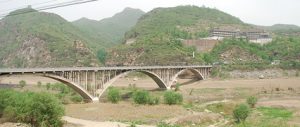If you wanted to trace the roots of Chinese civilization, you would do well to take a trip along the banks of the Han River. This 1,577-kilometre waterway flows through the heart of China, linking the Yangtze and Yellow River basins as it passes through the ancient states of Qin, Long, Ba and Shu and the Central Plain – known as the “cradle of Chinese civilisation”. Following the Han, you also follow the progress of the Chinese nation.
Amazingly, even in our industrialised era, the upper reaches of the Han still run clear. And it is this rare water quality, combined with the river’s convenient location, that has landed the Han a central role in a mega infrastructure scheme – China’s South-North Water Transfer Project. And it is this project that may cause the Han River to dry up.
As a result of the transfer project, plus another scheme to move water from the Han to the Wei River, by 2030 China will be drawing 15 billion cubic metres of water from the reaches of the Han River north of Danjiangkou, a city in Hebei province. This is about 40% of the river’s total flow, and enough to transform its ecology. Today, there are already almost 1,000 dams on the Han and its tributaries.
China’s water resources are very unevenly distributed. Figures show that 84% of water resources lie in or south of the Yangtze basin and only 9.9% in northern China. In the parched north, over-extraction of groundwater has become the only option. Former minister of water resources Wang Shucheng once said: “If groundwater extraction in the north of China continues at current rates, in about 15 years there will be none left.”
Responding to a report from the Yellow River Conservancy Commission in October 1952, Mao Zedong said: “There is plenty of water in the south, and little in the north – if it is possible, we should divert some of the flow.” And so the South-North Water Transfer Project was born.
In 2002, using water from the Han River to relieve the thirst of the north became a national ambition. In December that year, the State Council, the highest organ of government, approved the overall South-North Water Transfer Plan, announcing a 50-year, 486 billion yuan (US$73.6 billion) programme to channel water north along three routes – eastern, central and western.
The water that will come through the eastern route is polluted and, in the short term, only suitable for use in industry and agriculture. And although the countdown to the start of construction of the western route has already begun, opposition from Sichuan and a number of other provinces means it is not yet entirely clear that it will go ahead. And so the central route – the one that will divert clear water from the Han River – is eagerly anticipated in places like Beijing, Tianjin, Henan and Hebei.
The upper reaches of the Han River lie north of Danjiangkou. In 1958, a dam was built here, where the Han and Dan rivers meet, and this is where the central route of the water transfer project will start. Banners draped around the town proclaim that this “water capital” stands hand-in-hand with Beijing – and that it will deliver plenty of water north.
According to the plans, on completion of the second phase of this central route, 12 to 14 billion cubic metres of water will flow north each year. According to estimates from a project office in Shiyan city, Hubei, 38.8 billion cubic metres of water flow into Danjiangkou every year. The reservoir has a capacity of more than 29 billion cubic metres, when at its full 170-metre height. This means that even the first phase of the project – moving nine billion cubic metres of water a year – will result in the loss of one quarter of the river’s flow.
Also, Shaanxi is to start work at the end of the year on a long-planned project to use Han River water to supplement the flow of the Wei River. This will bring water from the Han over the Qinling mountains to Guanzhong and the Wei, the largest tributary of the Yellow River. This will relieve a severe water shortage for both businesses and residents in the major cities of Xi’an, Baoji, Weiyang and Xianyang, as well as 13 smaller cities including Xingping and Huayin.
The Han River nurtures southern Shaanxi. But north of the Qinling range, on the Guanzhong plain and in the north of the province, the water crisis is as bad as in the north of China. The Wei River, which those two areas rely on, has dried up repeatedly in recent years, and is so polluted that cities such as Xi’an have been forced to extract large quantities of groundwater.
Ever since Shaanxi revealed the plan to use Han River water to alleviate its water shortages, the province of Hubei, which lies on the middle and lower reaches of the Han, has been fighting it. According to Hubei, the South-North Water Transfer project will already cause water levels on the Han to drop, and Shaanxi’s scheme will exacerbate the situation. In response, Shaanxi has shifted its target of moving 1.5 billion cubic metres of water annually from 2015 to 2030.
Five hundred years ago, the Han River changed course to enter the Yangtze in Wuhan, the capital of Hubei province, giving the city its modern layout of three boroughs separated by rivers, and providing its 10-million strong population with an excellent supply of drinking water. For the 30 million who live along the banks of the Han in Hubei, the river is vital. Apart from a hiatus during the Cultural Revolution, discussions on the project have been continuing ever since it became a part of the Yangtze River Commission’s plans in 1959. And, as it will be hugely affected, Hubei has kept a close watch on the process throughout.
After work started on the project’s central route in 2002, Hubei’s South-North Water Transfer project office and the provincial environmental authorities jointly published a report on the environmental impact of the scheme on the middle and lower reaches of the Han River.
This was the first document to point out that, without proper management of that stretch of the river, a range of environmental and ecological problems would arise: the water flow and river level would fall and, as a result, the cost of using water would increase; the river’s ability to cleanse itself would decline, and so pollution control would get harder; the amount of time during which the river is navigable would decrease and water transport would therefore become less efficient – and shipping more costly; fish would suffer a loss of winter and breeding grounds, water temperature would fall and factors harmful to fish would rise.
Hubei’s constant research and advocacy efforts between 1987 and 2002 were not made in vain. The amount of water to be moved by the first stage of the central route was reduced repeatedly and, by the time work started in 2002, had fallen from the original 14.5 billion cubic metres to 9.5 billion cubic metres. A scheme to reduce the impact of the project on the middle and lower reaches of the Han River was formulated, and the date for the start of water transfer pushed back from 2010 to 2014.
Green Han River, founded in 2002 by Yun Jianli, is the only NGO working to protect the Han. It has over 3,000 volunteers, based in the city of Xiangfan. Yun said: “If anyone says that the project won’t have a negative impact on the Han River, on Xiangfan . . . well, I say they’re talking nonsense.”
At one point, the city of Xiangfan commissioned experts from the School of Environmental Engineering at Huazhong University of Science and Technology to investigate the issue. They found that, once water starts being taken from the Danjiangkou reservoir, more than half of firms and facilities in Xiangfan will struggle to obtain the water they need, or will have to be abandoned; 700,000 mu (around 467 square kilometres) of land will be damaged; and one third of local fish species lost. Also, reduced river flows will make the river less able to cleanse itself, and river water quality will fall by a grade.
But the biggest challenge the project faces may not be protection of water sources or calls for compensation from downstream communities, but resettlement. Between 1958 and 1967, around 480,000 people were moved from the Danjiangkou reservoir area. Following the 2005 expansion of the dam in preparation for the South-North Water Transfer Project, 330,000 people will again have to be moved – 230,000 of them out of the area completely.
Zhang Jiyao, former head of the State Council’s South-North Water Transfer Project Office, once told the magazine Outlook Weekly that these challenging relocation programmes were a major reason for project’s increasing costs and delays.
Hai Jie, a writer from Yunyang, wrote in his book The River Goes North: “I genuinely hope that when the clear river waters moisten the plains and cities of northern China, and the people happily lift their glasses of far-travelled water, they do not forget those who twice gave up their homes; that they do not forget the sacrifices and suffering of the past fifty years.”
An earlier version of this article was published in New Week, where Wang Kunzuo is a reporter. It is edited and used here with permission.
Homepage image from New Week shows the Danjiangkou dam.


